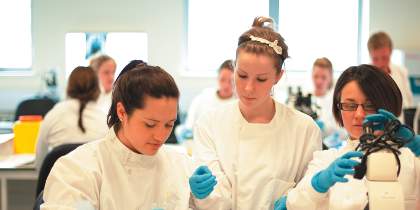
March 31, 2006, by Teaching at Nottingham
Using laboratory classes to teach experimental design
John Harris, Martin Luck and Alan Waterfall:
Background
“In previous years Animal Physiology students have carried out set laboratory experiments to illustrate the effects of exercise on cardiovascular responses. These were prescriptive laboratory sessions, each resulting in a written report. The teaching team felt that many students were completing these with insufficient thought and without achieving sufficient independence with regard to experimental design or the use of complex recording apparatus. This year the team tried a new approach which involved students designing the experiment for themselves over the course of two laboratory sessions held 3-4 weeks apart. Approximately 100 students were involved in this module and attended the same laboratory sessions with 3 members of staff, 4 demonstrators and a technician providing support. They worked in groups of 4 or 5.
Process
In the first session, the students carried out a set experiment on effects of posture change on cardiovascular measures in order to equip them with the necessary skills to carry out their own experiment. Other objectives were to:
- Organise and operate as a team
- Achieve familiarity with the recording instruments
- Introduce statistical analysis of dat
- Design and execute an experiment to investigate the effects of exercise on cardiovascular measures
“To help them design an appropriate experiment, students were provided with a set of guidance notes and an experimental design proforma to complete and submit to staff for checking prior to the second laboratory session. During the second session, students carried out their own experiment and analysed the data. Following the laboratory session, students had to complete an individual experimental report on a set proforma and submit this for assessment.
Assessment
Group and individual marks were awarded for different aspects of the laboratory sessions as follows:
| Aspect | % of mark | Group or Individual |
|---|---|---|
| Results table and graph from 1st experiment on postural change | 10 | G |
| Experimental design for own experiment on effects of exercise | 30 | G |
| Quality of experimental data from own experiment | 20 | G |
| Individual experiment report from own experiment | 40 | I |
Comments from Teaching Team
These are some comments from the teaching team about the benefits and disadvantages of this type of approach:
Dr. Martin Luck:”We were faced with the challenge of teaching practical aspects of cardiovascular physiology within a highly constrained timetable to a large class of students with little experience of using recording apparatus. Many of these students will take a third year module in which they have to plan and execute a large investigation in exercise physiology, so sound measurement and experimental design skills are crucial.
“Our solution was to use two of the scheduled practical sessions progressively (rather than for separate experiments as in previous years): a simple first experiment to ensure familiarity with kit and basic physiological parameters, a structured experimental design process, the completion of the designed study and the production of a structured report. Human physiology is ideal for small group work, although individual summative assessment can then be a problem. We decided to award most of the marks for group work and experimental design, and a smaller but significant proportion for the individual report. Establishing a fixed structure for each element ensured that learning objectives were met. It also helped to mitigate previously excessive marking loads.”
Dr. John Harris:”I think that by organising the practical classes in this way, we are taking a positive step towards encouraging students to think more carefully about (and experience) the pitfalls of the experimental process, which seem to especially apply to biological research due to its inherent variability. In this way, hopefully we can encourage students to be more applied scientists rather than achieving success by regurgitating facts by rote.”
Article written following a peer review of the lab session. Produced March 2006.
Dr John Harris
Lecturer in Neurophysiology
School of Biosciences
Prof Martin Luck
Associate Professor of Animal Physiology and Senior Tutor
School of Biosciences
Dr Alan Waterfall
Research Fellow
School of Biosciences
No comments yet, fill out a comment to be the first

Leave a Reply